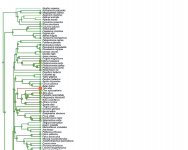Fred Ruhe
Well-known member

Peter Johnston & Kieren J. Mitchell, 2021
Contrasting Patterns of Sensory Adaptation in Living and Extinct Flightless Birds
Diversity. 13 (11): Article 538. doi:10.3390/d13110538
Abstract and free pdf: Contrasting Patterns of Sensory Adaptation in Living and Extinct Flightless Birds
Avian cranial anatomy is constrained by the competing (or complementary) requirements and costs of various facial, muscular, sensory, and central neural structures. However, these constraints may operate differently in flighted versus flightless birds. We investigated cranial sense organ morphology in four lineages of flightless birds: kiwi (Apteryx), the Kakapo (Strigops habroptilus), and the extinct moa (Dinornithiformes) from New Zealand; and the extinct elephant birds from Madagascar (Aepyornithidae). Scleral ring and eye measurements suggest that the Upland Moa (Megalapteryx didinus) was diurnal, while measurements for the Kakapo are consistent with nocturnality. Kiwi are olfactory specialists, though here we postulate that retronasal olfaction is the dominant olfactory route in this lineage. We suggest that the Upland Moa and aepyornithids were also olfactory specialists; the former additionally displaying prominent bill tip sensory organs implicated in mechanoreception. Finally, the relative size of the endosseous cochlear duct revealed that the Upland Moa had a well-developed hearing sensitivity range, while the sensitivity of the kiwi, Kakapo, and aepyornithids was diminished. Together, our results reveal contrasting sensory strategies among extant and extinct flightless birds. More detailed characterisation of sensory capacities and cranial anatomy in extant birds may refine our ability to make accurate inferences about the sensory capacities of fossil taxa.
Enjoy,
Fred
Contrasting Patterns of Sensory Adaptation in Living and Extinct Flightless Birds
Diversity. 13 (11): Article 538. doi:10.3390/d13110538
Abstract and free pdf: Contrasting Patterns of Sensory Adaptation in Living and Extinct Flightless Birds
Avian cranial anatomy is constrained by the competing (or complementary) requirements and costs of various facial, muscular, sensory, and central neural structures. However, these constraints may operate differently in flighted versus flightless birds. We investigated cranial sense organ morphology in four lineages of flightless birds: kiwi (Apteryx), the Kakapo (Strigops habroptilus), and the extinct moa (Dinornithiformes) from New Zealand; and the extinct elephant birds from Madagascar (Aepyornithidae). Scleral ring and eye measurements suggest that the Upland Moa (Megalapteryx didinus) was diurnal, while measurements for the Kakapo are consistent with nocturnality. Kiwi are olfactory specialists, though here we postulate that retronasal olfaction is the dominant olfactory route in this lineage. We suggest that the Upland Moa and aepyornithids were also olfactory specialists; the former additionally displaying prominent bill tip sensory organs implicated in mechanoreception. Finally, the relative size of the endosseous cochlear duct revealed that the Upland Moa had a well-developed hearing sensitivity range, while the sensitivity of the kiwi, Kakapo, and aepyornithids was diminished. Together, our results reveal contrasting sensory strategies among extant and extinct flightless birds. More detailed characterisation of sensory capacities and cranial anatomy in extant birds may refine our ability to make accurate inferences about the sensory capacities of fossil taxa.
Enjoy,
Fred




